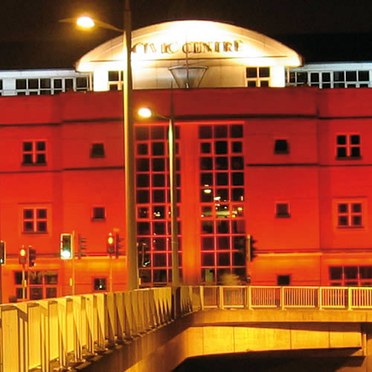Stoke Civic Centre, Staffordshire
- Lamp efficacy
Lamp efficacy
Ensuring the lamp efficiently converts electricity into light (lm/W).
- Ballast classification
Ballast classification
Controlling the electricity supply to the lamp (Energy Efficiency Index).
- Luminaire distribution
Luminaire distribution
Controlling light emission using optics which bend and shape the light to the correct location.
- System efficacy
System efficacy
Combining optical and thermal control within the luminaire (luminaire lm/W).
- Presence/absence detection
Presence/absence detection
Presence: Lights automatically turn on/off with movement. Absence: Lights automatically turn off and must be manually switched on.
- Daylight detection
Daylight detection
Artificial lighting which responds to the natural light conditions.
- Constant illuminance
Constant illuminance
A function designed to produce correct light levels for the duration of the maintenance period.
- Task-scene setting
Task-scene setting
Allowing the user to set scenes and adapt the lighting to different tasks.
- Timed off
Timed off
Automatic cut-off can be installed to turn all lights off during unoccupied hours.
- Task lighting
Task lighting
Lighting task areas with the correct amount of light.
- Zoning of lighting
Zoning of lighting
Lighting is zoned according to area use.
- Maintenance schedule
Maintenance schedule
Maintenance must be performed in response to product age, performance and environment.
- Waste light
Waste light
Eliminating waste light which does not hit the intended target.
- Reflectance
Reflectance
Taking advantage of light which is reflected from the surface within the space.
- Visible smart metering
Visible smart metering
Results of actions can be quickly seen as increased or decreased energy use to encourage responsible energy consumption.
Spectacular show puts the spotlight on Stoke
Stoke’s Civic Centre, located in the heart of the UK, has become a nightly attraction thanks to a splash of colour under a EUR 700,000 Living Lights project funded by the government. The colorful designs – created by city students of all ages, some as young as five – will change daily and can include stripes, cascades of colour, fades and many other variations.
There are more than 150 luminaires in the scheme including 1m long RGB LED Bands (at balcony and low level) and Contrast Spectra C2 250W colour changing floodlights 'washing’ the façade. The 16 surrounding street lanterns also feature banners lit by custom LED strips.
Schools, colleges and universities that are chosen to take part can access special software via the internet to design their light displays on-line and send them direct to the lights via a combination of web GUI and wireless (W-DMX) transmission.

